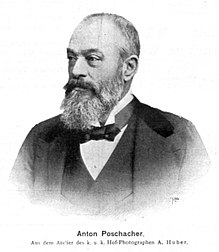Anton Poschacher (industrialist, 1841)
Anton Poschacher (born November 1, 1841 in Mauthausen ; † March 26, 1904 there ) was an Austrian stonemason , architect and industrialist from Mauthausen in Upper Austria . He owned the largest granite works of the Austro-Hungarian monarchy , which contributed significantly to the development of the Mauthausen stone industry with the mining, processing and delivery of Mauthausen granite .
Life
He was born the son of Anton Poschacher (1812–1873) and Aloisia Kamptner (1813–1893), the daughter of the wine merchant Kalkbrenners and quarry operator Leonhard Kamptner, who died in 1838 , was acquitted in 1862 as a stonemason, studied in Vienna at the Polytechnic Institute from 1859 to 1864 civil engineering and architecture at the Academy of Fine Arts Vienna from 1864 to 1869 . In 1868 he set up a law firm in Vienna and subsequently worked as the head of the Vienna branch for the family company.
In 1885 he married Louise Ried (1857–1933) from Vienna, in 1886 their daughter Marie Louise Poschacher (April 1, 1886 - August 16, 1965), their daughter Monika Poschacher (1888–1971) in 1888 and their son Anton Poschacher in 1889 born.
He was one of the co-founders of the Wiener Künstlerhaus and the Wiener Trabrennverein , of which he acted as its vice-president from 1893 to 1904; his friends included Hans Makart and Viktor Tilgner .
Entrepreneurial activity
In 1872, large parts of the property and his father's company were incorporated into the newly founded stock corporation for road and bridge construction based in Vienna , of which he became director after the death of his father in 1873. In view of the uneconomical management and the unbridled expansion through overpriced acquisitions of quarries in Upper Austria, Bavaria and Bohemia , however, he withdrew from the management and made an extensive study trip to the USA in 1876 .
In October 1876, with family loans, he bought the company, which had meanwhile been liquidated due to high losses, sold poorly located quarries and modernized the production facilities, for example by purchasing a diamond saw, a steam-powered grinding system and a crushed stone plant. From the 1880s the company developed into the largest granite producer in the Habsburg Monarchy . The company, which is now technically modern and equipped with its own transport fleet, was due to large orders for paving, hydraulic and bridge constructions, building construction projects and monuments, especially in Vienna and Budapest .
Of the 45 quarries that belonged to the company, 20 were in operation when he died, as well as extensive property holdings. In 1913, more than 2500 people worked in the Anton Poschacher granite works. After his death, his wife Louise and authorized signatory Franz Krammer continued to run the business until 1913, when his son Anton, who was also trained in the field, took over management.
Awards
- Honorary citizen of the Perg market
- Knight of the Franz Joseph Order
literature
- Andreas Resch: Poschacher, Anton. In: New German Biography (NDB). Volume 20, Duncker & Humblot, Berlin 2001, ISBN 3-428-00201-6 , p. 648 f. ( Digitized version ).
- Hj Zauner: Poschacher, Anton. In: Austrian Biographical Lexicon 1815–1950 (ÖBL). Volume 8, Verlag der Österreichischen Akademie der Wissenschaften, Vienna 1983, ISBN 3-7001-0187-2 , p. 218.
- Ernst Gusenbauer: In the quarry is a Leb´n - the rise and fall of the Mühlviertel stone industry using the example of Mauthausen (1870 to 1910) , in: Oberösterreichische Heimatblätter, Volume 44, Issue 4, Linz 1990, p. 298ff, online (PDF; 1.4 MB) in the forum OoeGeschichte.at
- Poschacher family - indestructible like granite, in: OÖN from September 25, 2010 article
- Anton Poschacher, Carl Costenoble: Architecture and public buildings, painting and sculpture, report on the world exhibition in Philadelphia 1876. Volume 14, 1877
Web links
- History of Granitwerke Anton Poschacher
- Entry on Poschacher, Anton in the Austria Forum (in the AEIOU Austria Lexicon )
Individual evidence
| personal data | |
|---|---|
| SURNAME | Poschacher, Anton |
| BRIEF DESCRIPTION | Austrian stonemason, architect, industrialist |
| DATE OF BIRTH | November 1, 1841 |
| PLACE OF BIRTH | Mauthausen |
| DATE OF DEATH | March 26, 1904 |
| Place of death | Mauthausen |
